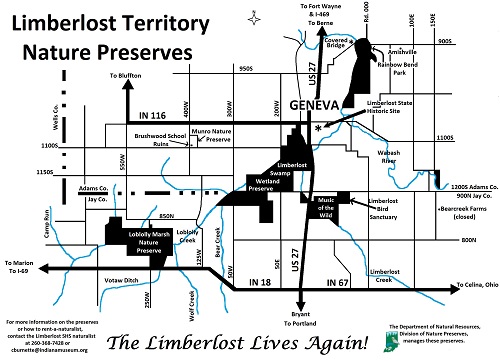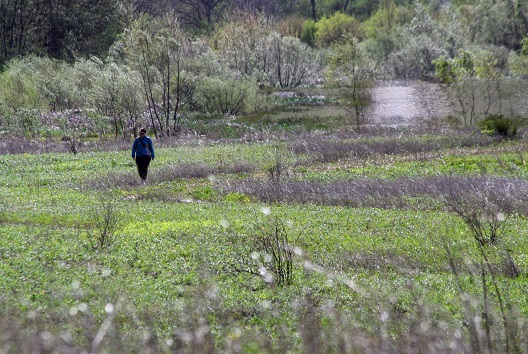Loblolly Marsh Nature Preserve is Indiana’s 250th dedicated nature preserve. Its 475 acres include marsh, forest, and prairie. The preserve is open to the public from dawn to dusk and features a tree identification trail, approximately 3.5 miles of easy walking trails, and a ¼ mile ADA handicapped-accessible trail with benches. The preserve is located 3 miles west of Bryant on Hwy 18, turn north on County Road 250W, and travel ½ mile to the parking lot: 8323N 250W, Bryant, IN 47326. The preserve is on both sides of the road and parking is available north of the Loblolly Creek. Scroll down this page for more trail information.

If visitors would like a more in-depth and personalized visit, a rent-a-naturalist program is available through the Limberlost State Historic Site. A Limberlost naturalist will walk with you along the trails and point out the plants and animals of the preserve and also describe the history of the land, including how Gene Stratton-Porter studied, wrote about, and photographed the area. For more information contact Curt Burnette, Limberlost Site Naturalist: 260-368-7428 or cburnette@indianamuseum.org
History of Loblolly Marsh Nature Preserve
This land was purchased from five different landowners who entered their land into the Wetland Reserve Program. The residual value was purchased using Indiana Heritage Trust funds. Other donors include ACRES Land Trust, Ropchan Foundation, M.E. Raker Foundation and Friends of the Limberlost/Limberlost Swamp Remembered Committee. The restoration of the wetlands began in 1992.
Many of the soils in the Loblolly Marsh are floodplains that connect to the Wabash River and they support river bulrush, sedges and prairie cord grass. Several muck flats support bur reed and cattail marshes. The upland areas are equally divided with prairie and restored forest land. A twenty-five acre mature woodland is a mixture of upland and bottomland hardwood trees.
This area was drained by a steam powered dredge from 1888 to 1910. During these years of drainage, Gene Stratton-Porter wrote the majority of her most successful novels and nature studies about the Limberlost area. The Loblolly Marsh was the heart of the Limberlost. Once the wetlands were converted to farmland, and cropped from 1910 until restoration in 1992, crop losses from periodic flooding plagued the landowners almost yearly. But the biggest losses were the many species of plants and animals documented in Porter’s books.
The Loblolly Marsh is a wetland complex containing emergent bur reed and cattail marshes where waterfowl reproduce. During drier times of the year, the marsh may have large mudflats exposed and shorebirds visit the area. Fall months are primed for the many migrating birds that feed on the abundant growth of annual plants. Winter months are a flurry of activity with all of the northern migrants and an occasional snowy owl.
In the spring, small potholes serve as mating areas for several species of amphibians. Sedge meadows and wet meadows are deafening with the calls of several frog species including northern leopard frogs. The woodland has a wide array of plants and the colors begin early. Waterfowl find nesting sites in the prior year’s growth of tall grass prairie. In late summer and early fall, the prairies explode with native plants that expose their flowers throughout the area.





